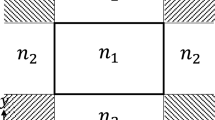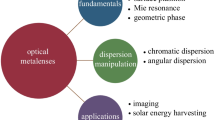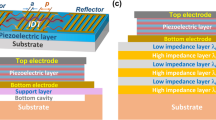Abstract
In this paper, negative permeability metamaterial medium is modeled using the split-ring resonator (SRR) structure and is fabricated for use in waveguides as filter. Starting from the basic resonant and magnetic plasma frequency equations, effects of the various structural parameters of the SRR on its performance are studied for the desired resonant frequency. After the optimization study of the SRR unit cell, an SRR array is modeled. Effects of the orientation of the rings and the array, and the position of the array are also studied for the best filter response. The optimization studies are carried out using the commercial solver, CST MWS. Finally, the SRR array consisting of 135 unit cells is fabricated on a conventional FR4 substrate using PCB printing technique. The SRR array is also fabricated on a non-conventional silicon substrate using UV-LIGA technique. Both the arrays are tested and the experimental results are compared with the simulation results.











Similar content being viewed by others
References
Anantha Ramakrishna S (2005) Physics of negative refractive index materials. Institute of Physics Publishing. Rep Prog Phys 68:449–521
Aydin K, Bulu I, Guven K, Kafesaki M, Soukoulis CM, Ozbay E (2005) Investigation of magnetic resonances for different split-ring resonator parameters and designs. New J Phys 7:168
Baena JD, Bonache J, Martin F, Sillero RM, Falcone F, Lopetegi T, Laso MAG, Garcia-Garcia J, Gil I, Portillo MF, Sorolla M (2005) Equivalent circuit models for split ring resonators and complementary split ring resonators coupled to planar transmission lines. IEEE Trans MTT 53(4):1451–1461
Bilotti F, Sevgi L (2012) Metamaterials: Definitions, properties, applications, and FDTD-based modeling and simulation. Int J RF Microw Comput Aided Eng 22:4
Bilotti F, Toscano A, Vegni L (2007) Design of spiral and multiple split-ring resonators for the realization of miniaturized metamaterial samples. IEEE Trans Antennas Propag 55(8):2258–2267
Capolino F (ed) (2009a) Metamaterials handbook: theory and phenomena of metamaterials. CRC Press, Taylor and Francis Group, Boca Raton, p 16-1
Capolino F (ed) (2009b) Metamaterials handbook: applications of metamaterials. CRC Press, Taylor and Francis Group, Boca Raton
Chen CY, Yen TJ (2009) Electric and magnetic responses in the multiple-split ring resonators by electric excitation. J Appl Phys 105:124913
Chen X, Grzegorczyk TM, Bae-Ian W, Pacheco Jr J, Kong JA (2004) Robust method to retrieve the constitutive effective parameters of metamaterials. Phys Rev E 70(1):016608
Chen JY, Chen WL, Yeh JY, Chen LW, Weng CC (2009) Comparative analysis of split-ring resonators for tunable negative permeability metamaterials based on anisotropic dielectric substrates. PIER M 10:25–38
CST Microwave Studio (2010) CST Studio Suite. Darmstadt, Germany
Ekmekci E, Turhan-Sayan G (2009) Comparative investigation of resonance characteristics and electrical size of the double-sided SRR, BC-SRR and conventional SRR type metmaterials for varying substrate parameters. PIER B 12:35–62
Ekmekci E, Averitt RD, Turhan-Sayan G (2010) Effect of substrate parameters on the resonanace frequency of double-sided SRR structures under two different excitations. In: PIERS proceedings. Cambridge, USA, July, pp 5–8, 2010
Hrabar S, Bartolic J, Sipus Z (2005) Waveguide miniaturisation using uniaxial negative permeability medium. IEEE Trans Antennas Propag 53:1
Katsarakis N, Koschny T, Kafesaki M, Economou EN, Soukoulis CM (2004) Electric coupling to the magnetic resonance of split ring resonators. Appl Phys Lett 84(15):2943–2945
Kim IK, Varadan VV (2009) Electric and magnetic resonances in symmetric pairs of split ring resonators. J Appl Phys 106:074504
Marques R, Mesa F, Martel J, Medina F (2003) Comparative analysis of edge- and broadside-coupled split ring resonators for metamaterial design—theory and experiments. IEEE Trans Antennas Propag 51:10
Marques R, Martin F, Sorolla M (2007) Metamaterials with negative parameters: theory, design and microwave applications. Wiley Series, New York
Meng FY, Wu Q, Liang Y, Zhang K, Le-Wei L (2009) Design, fabrication and testing of three-dimensional rectangular cavity resonator based on metamaterial. IEEE Trans Magn 45(10):4329–4332
Pendry JB, Holden AJ, Stewart WJ, Youngs I (1996) Extremely low frequency plasmons in metallic mesostructures. Phys Rev Lett 76(25):4773–4776
Pendry JB, Holden AJ, Robbins DJ, Stewart WJ (1999) Magnetism from conductors and enhanced nonlinear phenomena. IEEE Trans Microw Theory Tech 47:11
Sheng Z, Varadan VV (2007) Tuning the effective properties of metamaterials by changing the substrate properties. J Appl Phys 101:014909
Stefanovski SL, Potrebic MM, Tosic DV (2013) Design and analysis of bandpass waveguide filters using novel complementary split ring resonators. In: Telsiks 2013, Serbia, Nis, October 16–19, 2013, pp 257–260
Tang Q, Meng F-Y, Qun W, Lee J-C (2011) A balanced composite backward and forward compact waveguide based on resonant metamaterials. J Appl Phys 109:07A319
Vaselago VG (1968) The electrodynamics of substances with simultaneously negative values of ε and μ. Sov Phys 10:4
Zhang J, Hu ZR (2010) A novel broadband metamaterial resonator with negative permittivity. In: PIERS Proceedings, Xi’an, China, March 22–26, 2010, pp 1346–1348
Acknowledgments
The authors would like to thank the Director, CSIR-CEERI for providing the opportunity to carry out the work. The authors are also thankful to members of Klystron Laboratory for providing Vector Network Analyzer and waveguide to carry out the experiment and to all members of MEMS Laboratory for help in smooth fabrication.
Author information
Authors and Affiliations
Corresponding author
Rights and permissions
About this article
Cite this article
Purushothaman, N., Jain, A., Taube, W.R. et al. Modeling and fabrication studies of negative permeability metamaterial for use in waveguide applications. Microsyst Technol 21, 2415–2424 (2015). https://doi.org/10.1007/s00542-014-2402-6
Received:
Accepted:
Published:
Issue Date:
DOI: https://doi.org/10.1007/s00542-014-2402-6




